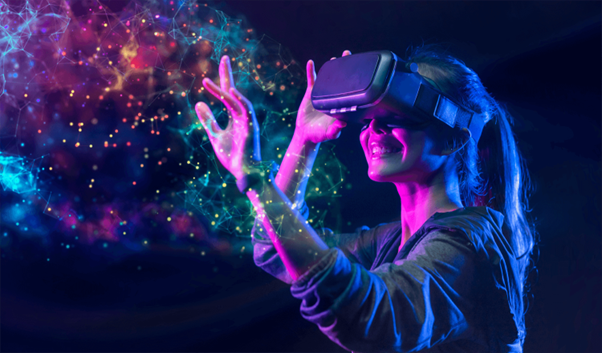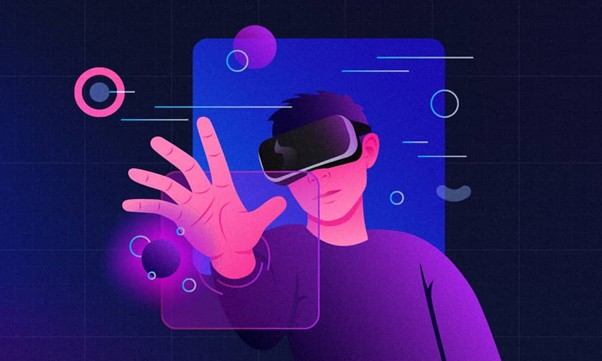XR Digital
At XR Digital, we blend creativity, technology, and strategy to deliver unparalleled digital solutions. Explore the possibilities with us as we push the boundaries of innovation and transform your vision into reality.

In the contemporary digital era, users are seeking more immersive and engaging experiences. Traditional two-dimensional interfaces are gradually becoming obsolete as consumers crave content that transports them to alternate realities.
In the ever-evolving landscape of technology, Virtual Reality (VR) has emerged as a revolutionary force, transforming the way we experience digital content. From gaming and entertainment to education and healthcare, VR has found applications in diverse fields.
Before embarking on VR app development, it’s crucial to refine your concept. Understanding user needs, market trends, and potential applications such as virtual reality in healthcare can shape a compelling and impactful VR experience. Refining your app idea involves a comprehensive process, ensuring that it aligns with user expectations and stands out in a competitive landscape.
As the demand for immersive experiences continues to grow, so does the need for innovative VR applications. This article delves into the world of VR app development, exploring the challenges, opportunities, and intricate process of creating virtual reality experiences.

Virtual Reality (VR) app development has come a long way since its inception. The early attempts at VR were characterized by rudimentary technologies and limited capabilities. One of the pioneering moments in VR history was the creation of the Sensorama by Morton Heilig in the 1950s. This device provided a multisensory experience, incorporating stereoscopic 3D visuals, stereo sound, and even smells, laying the foundation for immersive experiences.
The 1990s witnessed a surge in interest with the release of Virtuality Group’s arcade machines, bringing VR to a broader audience. However, these early endeavors were plagued by technical limitations, including bulky hardware and low-quality graphics. The enthusiasm waned as the technology struggled to meet the expectations set by science fiction.
The landscape of VR app development has undergone a paradigm shift in recent years. Advances in hardware, particularly with the introduction of more compact and powerful VR headsets, have played a pivotal role. Oculus Rift, HTC Vive, and PlayStation VR are just a few examples of the devices that have contributed to the mainstream adoption of VR.
As VR app development continues to evolve, several trends and technologies are poised to shape its future. One of the key areas of focus is the improvement of haptic feedback, aiming to enhance the sense of touch within virtual environments. Advancements in eye-tracking technology also hold promise for more natural and intuitive interactions, as the VR system can respond to the user’s gaze.

The journey of VR app development begins with a robust ideation and concept development phase. Developers need to envision the immersive experiences they want to create and identify the target audience. This stage involves brainstorming creative ideas that leverage the unique capabilities of VR, whether in gaming, simulations, or other applications.
Prototyping is a crucial step in refining the VR app’s design. Developers often create wireframes and basic prototypes to test the core functionalities and user interactions. Design considerations in VR extend beyond traditional 2D interfaces. Factors like spatial awareness, depth perception, and user comfort play pivotal roles in crafting a seamless and enjoyable experience.
Selecting the appropriate development platform is a critical decision that influences the success of a VR app. Unity, Unreal Engine, and ArKit are popular choices, providing powerful tools and resources for VR development. Each platform has its strengths and weaknesses, and the decision often depends on factors like the project scope, target devices, and the development team’s expertise.
VR app development requires proficiency in specific programming languages. C# is commonly used with Unity, while Unreal Engine primarily relies on C++. Understanding these languages is essential for implementing core functionalities, optimizing performance, and troubleshooting potential issues that may arise during development.
Graphics and rendering are fundamental aspects of VR app development, directly impacting the visual quality and overall immersion. Developers employ advanced rendering techniques such as ray tracing to achieve realistic lighting and reflections. Optimizing graphics for VR involves striking a balance between visual fidelity and performance to ensure a smooth experience on a variety of hardware. Integrating artificial intelligence into VR applications enhances their capabilities. Examples of artificial intelligence in VR include intelligent avatars, adaptive environments, and personalized experiences.
User interaction in VR extends beyond traditional input methods. Motion controllers, hand tracking, and even gaze-based interactions add layers of complexity to the design process. Crafting an intuitive and user-friendly experience requires a deep understanding of how users will navigate and interact within the virtual space. User experience design in VR involves minimizing discomfort, optimizing navigation, and maximizing engagement. Integrating artificial intelligence into VR applications enhances their capabilities.

Despite the remarkable progress in VR technology, accessibility and affordability of VR hardware remain significant challenges. High-quality VR headsets and accessories can be expensive, limiting widespread adoption. Developers face the challenge of creating content that caters to a diverse audience with varying levels of hardware capabilities. Efforts to make VR more accessible involve developing applications that can run on a range of devices, from high-end VR headsets to more budget-friendly alternatives.
VR app development introduces a unique learning curve for developers unfamiliar with the intricacies of virtual reality. Mastery of specialized tools, platforms, and techniques is essential. Educational resources, online communities, and collaborative learning environments play a crucial role in mitigating this challenge. As the developer community grows, so does the collective knowledge base, making it easier for newcomers to enter the VR development space.
Creating compelling and engaging content for VR presents its own set of challenges. Developers must consider not only the technical aspects but also the narrative and experiential elements that define successful VR experiences. Collaborations between developers, storytellers, and artists become crucial in crafting immersive content that resonates with users. Additionally, addressing issues such as motion sickness and discomfort requires a deep understanding of human perception and psychology.

Examining successful VR apps provides valuable insights into best practices and challenges faced during development. One notable example is “Beat Saber,” a rhythm-based VR game that gained immense popularity. The developers focused on intuitive controls, engaging gameplay, and regular content updates, contributing to its success. Understanding the stories behind such apps helps developers learn from real-world experiences and refine their own development strategies.
Case studies also shed light on the challenges faced by developers. Issues such as hardware limitations, user feedback, and unexpected technical hurdles are common in the dynamic field of VR app development. Learning from these challenges enables developers to anticipate potential issues and implement effective solutions in their projects.
Analyzing the impact of VR apps on user engagement and satisfaction is crucial for measuring success. Successful apps not only provide immersive experiences but also offer meaningful and enjoyable interactions. User feedback, reviews, and analytics play a vital role in understanding how well an app resonates with its audience, guiding developers in refining their creations for maximum impact.

Looking ahead, the future of VR holds promises of continued innovation. The exploration of virtual reality in social media and marketing is expected to grow, reshaping how users interact with content. As VR technology advances, its integration with other technologies like AR (as seen in ARKit) adds new dimensions to immersive experiences.
The future of VR app development is intertwined with emerging technologies that promise to redefine the possibilities within virtual reality. One such technology is augmented reality (AR), which blends the virtual and physical worlds. The convergence of VR and AR, often referred to as mixed reality (MR), opens up new avenues for interactive and immersive experiences. This integration allows users to seamlessly transition between fully virtual environments and those that overlay digital information onto the real world.
Advancements in hardware are poised to elevate the VR experience to new heights. Lightweight, high-resolution headsets with improved field-of-view are on the horizon, offering users a more comfortable and visually impressive experience. Haptic feedback technology is likely to become more sophisticated, enabling users to feel a greater range of sensations within virtual environments.
While gaming has been a driving force in the growth of VR, its applications extend far beyond entertainment. In healthcare, VR is being used for medical training, therapy, and simulations. Educational institutions are leveraging VR to create immersive learning environments, allowing students to explore historical events or conduct virtual science experiments. The real estate industry is adopting VR for virtual property tours, enabling prospective buyers to experience spaces remotely.

The rise of VR technology brings forth ethical considerations that developers must grapple with. Privacy concerns related to data collection and user tracking within virtual environments need careful attention. Ensuring transparent data policies and prioritizing user consent are essential to maintaining ethical standards in VR app development.
Health and safety issues, such as motion sickness and eye strain, are challenges that developers must address. Designing VR experiences that prioritize user comfort and minimize potential adverse effects is crucial. Continuous research into the physiological impact of VR and the implementation of best practices contribute to creating safer and more enjoyable virtual experiences.
Inclusivity and accessibility are paramount in VR app development. Ensuring that VR experiences cater to diverse audiences, including those with disabilities, requires a conscious effort. Implementing features such as customizable controls, subtitles, and options for varied mobility levels enhances the accessibility of VR applications. Developers must adopt inclusive design principles to create virtual worlds that everyone can enjoy.

Developing VR apps involves several key steps:

In this comprehensive exploration of VR app development, we’ve journeyed through the evolution of VR technology, delved into the intricacies of the development process, and examined the current state of VR applications. From early attempts and milestones to the potential breakthroughs on the horizon, the landscape of VR app development is dynamic and full of promise.
In the rapidly evolving landscape of technology, the fusion of virtual reality (VR) has become a transformative force, reshaping the way we experience digital content. This paradigm shift aligns seamlessly with the innovative services offered by XR Digital. Specializing in Extended Reality, XR Digital’s expertise encompasses diverse sectors, including gaming, simulations, and social media integration.
XR Digital, with its commitment to cutting-edge technology, is positioned as a key player in shaping the future of immersive social interactions, echoing the sentiments expressed in the exploration of VR’s applications in the social media realm.
The programming language for VR development depends on the chosen development platform. Commonly used languages include; Unity: Primarily uses C# for scripting; Unreal Engine: Primarily uses C++ for programming.
Being a VR developer can be a rewarding career, especially as VR technology continues to advance and find applications in diverse industries. The demand for skilled VR developers is expected to grow, making it a potentially good job for those with a passion for immersive technologies.
While virtual reality (VR) and artificial intelligence (AI) are distinct technologies, they can complement each other. AI can enhance VR experiences by enabling intelligent interactions within virtual environments, creating more dynamic and responsive simulations.
The future of VR holds exciting possibilities. Emerging technologies like augmented reality (AR) integration, improved hardware, and advancements in AI are expected to shape more realistic and interactive VR experiences. VR is likely to continue expanding into various industries beyond gaming, including healthcare, education, and business.
At XR Digital, we blend creativity, technology, and strategy to deliver unparalleled digital solutions. Explore the possibilities with us as we push the boundaries of innovation and transform your vision into reality.